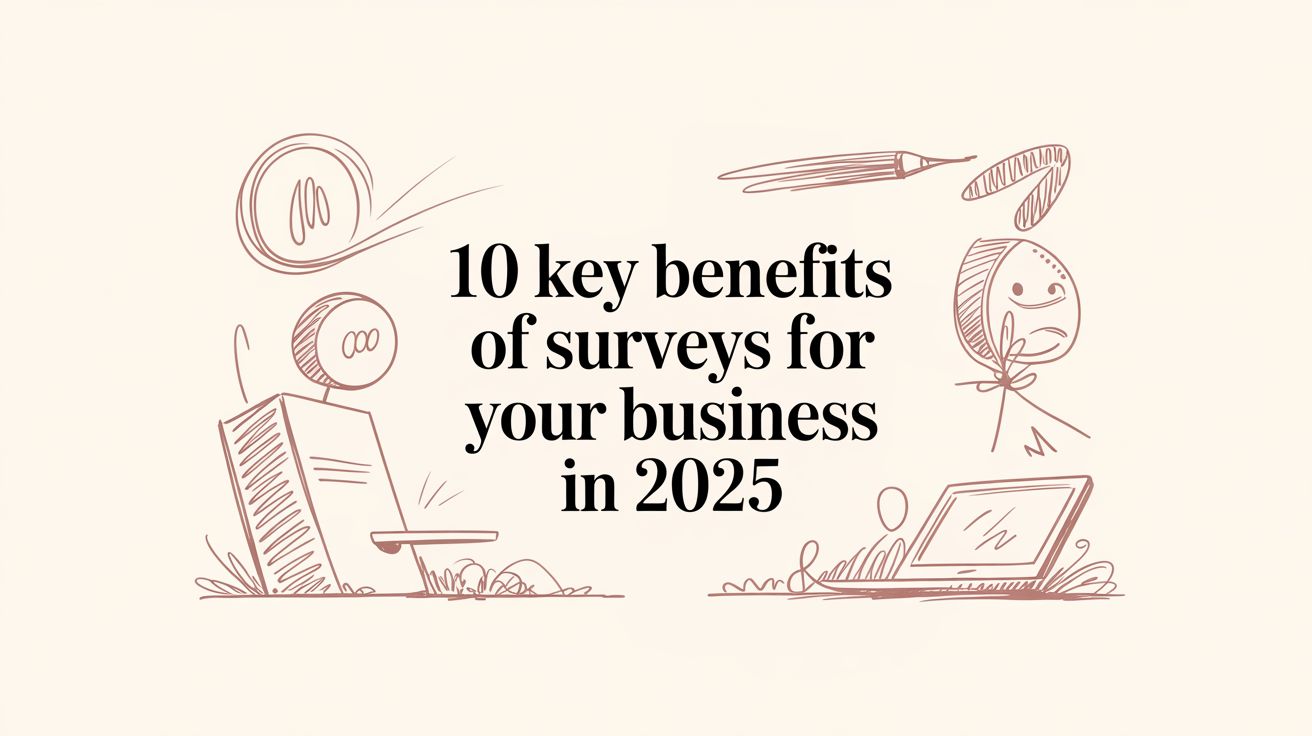10 Key Benefits of Surveys for Your Business in 2025

In today's competitive market, understanding your customers, employees, and competitive landscape is non-negotiable. While gut feelings can sometimes point you in the right direction, data-driven decisions are what truly separate thriving organisations from those that merely survive. Surveys are one of the most powerful, versatile, and cost-effective tools for gathering this crucial data. Far from being a simple Q&A, a well-designed survey is a strategic conversation with your most important stakeholders.
It’s an opportunity to listen at scale, identify hidden opportunities, and proactively address challenges before they escalate. This article explores the top 10 benefits of surveys, providing a comprehensive guide to leveraging this indispensable tool for sustainable growth and a deeper connection with your audience. We'll delve into practical applications, from measuring customer satisfaction to shaping your next product launch, demonstrating how strategic feedback collection can become the bedrock of your success. With platforms like Good Kudos, you can transform this feedback into powerful social proof.
1. Cost-Effective Data Collection
One of the most significant benefits of surveys is their remarkable cost-effectiveness. Traditional research methods like focus groups or face-to-face interviews often require substantial investment in time, travel, and personnel. Surveys, especially digital ones, slash these expenses, providing a powerful yet economical way to gather vast amounts of data. This allows organisations of any size, from small charities to growing e-commerce stores, to access high-quality insights without a prohibitive budget.

The minimal cost per respondent means you can reach a broader, more diverse audience, strengthening the validity of your findings. For example, a non-profit can conduct a community needs assessment via an email survey, reaching hundreds of people for a fraction of the cost of door-to-door polling.
Actionable Tips for Implementation
- Start with Free Tools: For basic data collection, platforms like Google Forms are free and highly effective.
- Calculate True ROI: Factor in the time spent on design, distribution, and analysis to understand the full cost and return on your investment.
- Integrate for Efficiency: Connect your surveys to other business tools. For instance, linking feedback surveys to a testimonial platform like Good Kudos automates the process of collecting and showcasing positive reviews, saving you valuable time and maximising the impact of your data.
2. Quick Insights and Rapid Feedback
Another of the key benefits of surveys is their ability to deliver rapid feedback. In today's fast-paced market, organisations cannot afford to wait weeks or months for insights. Digital surveys enable you to gather actionable data in days or even hours, allowing you to make timely decisions, respond to market shifts, and iterate on products or services with minimal delay. This speed is crucial for maintaining a competitive edge and staying aligned with customer expectations.

This agility transforms how you operate. For instance, a software company can deploy a post-update satisfaction survey within hours to quickly identify bugs or user frustrations. Similarly, a local service provider can survey clients immediately after a job is completed to gauge satisfaction while the experience is still fresh. This immediacy ensures the feedback is relevant and can be acted upon swiftly to improve service quality.
Actionable Tips for Implementation
- Create Templates: Have survey templates pre-built for common scenarios like post-purchase feedback or event follow-ups to launch them instantly.
- Use Mobile-First Surveys: Design surveys that are easy to complete on mobile devices to capture real-time feedback from people on the go.
- Automate Feedback Loops: Use platforms like Good Kudos to automatically send feedback requests after a service or purchase. This not only gathers quick insights but also streamlines the process of capturing testimonials to build social proof.
3. Large-Scale Data Collection and Statistical Validity
Another key benefit of surveys is their capacity for large-scale data collection, which provides a foundation for statistically valid conclusions. Unlike smaller-scale qualitative methods, surveys can reach thousands or even millions of respondents, allowing you to generate robust datasets that accurately reflect broader population trends. This scale is what empowers organisations like Gallup or the U.S. Census Bureau to generalise their findings with a high degree of confidence.

When you collect data from a large, representative sample, your insights are no longer just anecdotal. They become statistically significant, allowing you to make strategic decisions backed by reliable evidence. A market research firm, for example, can confidently advise a client on product-market fit after surveying 5,000+ potential customers.
Actionable Tips for Implementation
- Use Sample Size Calculators: Before launching, use an online calculator to determine the number of responses needed for your desired confidence level and margin of error.
- Ensure Proper Sampling: Employ random or stratified sampling methods to ensure your audience sample is representative of the larger population you want to analyse.
- Automate Feedback Loops: Use customer feedback surveys at scale to automatically identify positive sentiment. A tool like Good Kudos can then capture this feedback and turn it into powerful testimonials, streamlining your review collection process.
4. Customer Satisfaction and Experience Insights
One of the core benefits of surveys is their ability to directly measure and track customer satisfaction. By deploying targeted questionnaires, organisations can gather quantitative metrics like Net Promoter Scores (NPS) and Customer Satisfaction (CSAT) scores, providing a clear benchmark of performance. This data illuminates the entire customer journey, pinpointing service gaps, highlighting areas of excellence, and revealing crucial opportunities for improvement.

This process is more than just data collection; it demonstrates a genuine commitment to customer-centric values. For instance, an airline using a post-flight survey to ask about the check-in process or an e-commerce store requesting product feedback shows customers their opinions are valued. Acting on this feedback is what transforms a good experience into a great one, fostering loyalty and advocacy.
Actionable Tips for Implementation
- Keep It Brief and Focused: To maximise completion rates, keep satisfaction surveys short, ideally between 5-10 questions focused on a specific interaction.
- Time Your Surveys Consistently: For accurate trend analysis, send surveys at the same point in the customer journey, such as immediately after a purchase or service interaction.
- Automate Feedback Collection: Use a dedicated platform to streamline the process. A tool like Good Kudos can automatically request feedback and help you convert positive responses into powerful testimonials, closing the loop and celebrating customer success.
5. Market Research and Competitive Analysis
Surveys are an indispensable tool for gaining competitive intelligence and understanding broader market trends. They allow you to look beyond your own customer base to assess competitor positioning, identify gaps in the market, and validate new product ideas. This is one of the key benefits of surveys, as it provides objective data to guide strategic decisions, from product development to pricing.
This proactive approach helps you stay ahead of the curve. For example, a tech startup can survey potential users about feature preferences in competitor products before launching their own, ensuring they enter the market with a superior offering. Similarly, a fashion brand can use surveys to gauge the viability of upcoming trends among their target demographic.
Actionable Tips for Implementation
- Benchmark Against Competitors: Design survey questions that ask respondents to compare your offerings directly against those of your main competitors.
- Segment Your Analysis: Analyse survey data by demographic segments to understand how different groups perceive the competitive landscape.
- Time Your Research: Conduct surveys before making significant strategic moves, such as launching a new product line or entering a new market.
- Automate Feedback Collection: After gathering market insights, use a tool like Good Kudos to automatically collect and display positive customer testimonials, reinforcing your competitive strengths.
6. Employee Engagement and Organisational Development
Surveys are a powerful tool for looking inward, providing a clear window into employee satisfaction, company culture, and overall organisational health. By moving beyond assumptions, internal surveys allow leaders to gather concrete data on what motivates, engages, or frustrates their teams. This information is vital for driving meaningful HR initiatives, developing effective leadership, and creating a workplace that boosts both retention and productivity.
These insights are one of the most strategic benefits of surveys, as they directly impact your greatest asset: your people. For example, a growing tech firm can use regular pulse surveys to get real-time feedback on new policies, while a non-profit can assess staff morale during periods of change to provide targeted support. This proactive approach helps build a responsive and supportive company culture.
Actionable Tips for Implementation
- Guarantee Anonymity: Ensure responses are anonymous to encourage candid and honest feedback. This builds trust and improves the quality of the data you receive.
- Conduct Pulse Surveys: Don't wait for an annual review. Use shorter, more frequent pulse surveys (e.g., quarterly) to track engagement and address issues before they escalate.
- Share and Act on Results: Be transparent with your findings. Share a summary of the results with employees and outline the specific action plans you will implement based on their feedback to close the loop.
- Celebrate Success: Use positive internal feedback to recognize teams and individuals. Platforms like Good Kudos can also be used internally to create a culture of appreciation and showcase employee achievements.
7. Risk Identification and Problem Prevention
Another of the key benefits of surveys is their power as an early warning system. They help organisations proactively identify potential risks, emerging problems, and areas of concern before they escalate into full-blown crises. By systematically gathering feedback, you can spot negative trends and address them head-on, turning reactive crisis management into proactive problem-solving. This foresight is invaluable for maintaining stability and reputation.
For example, a university can survey students about mental health resources, identifying gaps in support before they affect student well-being on a larger scale. Similarly, a manufacturing firm can use staff surveys to flag potential equipment reliability risks, preventing costly downtime and safety incidents. This preventative approach saves resources and builds trust with stakeholders, showing you are attentive and responsive.
Actionable Tips for Implementation
- Establish a Baseline: Conduct regular surveys to create baseline metrics. This makes it easier to spot deviations and negative trends over time.
- Analyse for Patterns: Don't just look at individual responses. Use trend analysis to identify deteriorating patterns or recurring issues that signal an underlying problem.
- Act on Findings Promptly: To maintain credibility, act swiftly on identified risks. A quick response shows your audience that their feedback is valued and taken seriously.
8. Stakeholder Engagement and Democratic Decision-Making
Surveys offer a powerful tool for democratising decision-making, ensuring that diverse stakeholder voices are heard and valued. By systematically gathering input from employees, customers, community members, or shareholders, organisations can foster a more inclusive and collaborative environment. This approach not only builds trust and legitimacy but also leads to more robust and widely supported outcomes, as decisions are based on collective wisdom rather than top-down assumptions.
This method transforms feedback from a simple metric into an active part of your governance. For example, a local council can survey residents on budget priorities, ensuring public funds are allocated to services the community truly values. Similarly, a university might poll students on campus improvements, making them active participants in shaping their educational experience. This is one of the key benefits of surveys for community-focused organisations.
Actionable Tips for Implementation
- Communicate the "Why": Clearly explain how survey results will influence decisions to encourage thoughtful participation.
- Ensure Accessibility: Make sure your survey is accessible to all stakeholders, considering different languages, abilities, and levels of digital literacy.
- Report Back Transparently: Share the survey findings and explain how they informed the final decisions, even if some suggestions were not adopted. This closes the feedback loop and shows respect for the input provided.
9. Testing Hypotheses and Validating Assumptions
One of the most powerful benefits of surveys is their role as a scientific tool for risk mitigation. Businesses often operate on assumptions about customer needs, market demand, or campaign effectiveness. Surveys provide an empirical framework to test these hypotheses before committing significant resources, transforming guesswork into data-driven strategy and preventing costly mistakes. This approach, popularised by the Lean Startup methodology, is crucial for innovation and sustainable growth.
By collecting direct feedback, you can validate or disprove your theories with real-world evidence. For example, a tech startup can survey potential users to gauge interest in a new feature, or a retailer can test different price points to predict customer response. This proactive validation ensures that business decisions are based on what the market actually wants, not just what the organisation thinks it wants, leading to more successful outcomes.
Actionable Tips for Implementation
- Define Clear Hypotheses: Before creating your survey, state your assumption as a testable hypothesis, such as "Our target audience values feature X more than feature Y."
- Test Multiple Scenarios: Don't just test one idea. Present respondents with several different messages, price points, or concepts to see which performs best.
- Combine Feedback with Behaviour: While survey data is valuable, supplement it with behavioural analytics where possible to confirm that stated preferences align with actual actions. The insights gained can then fuel your customer testimonial strategy on platforms like Good Kudos, ensuring your showcased feedback is both authentic and impactful.
10. Accountability, Transparency, and Evidence-Based Practice
Surveys provide documented evidence that underpins organisational decisions, fostering a culture of accountability and transparency. This data-driven approach supports evidence-based practice, demonstrating a clear commitment to stakeholders and measurable outcomes. When organisations use survey data to explain their actions, they build trust and show they are responsive to the needs of those they serve. This is one of the key benefits of surveys for mission-driven organisations.
This practice is essential for sectors where trust is paramount. For example, a local council can use citizen satisfaction surveys to justify budget allocations, while an NGO can use beneficiary feedback to report on project impact to its funders. This creates a powerful feedback loop that reinforces responsible governance and continuous improvement.
Actionable Tips for Implementation
- Establish a Baseline: Conduct an initial survey to establish a clear baseline. This allows you to track progress and measure the impact of your initiatives over time.
- Maintain Consistency: Use consistent methodologies and questions in your surveys year-over-year to ensure the data is comparable and trends are accurately identified.
- Report Your Findings: Publicly share high-level survey results and outline the actions you plan to take based on the feedback. Transparency builds credibility and keeps you accountable.
Top 10 Survey Benefits Comparison
| Item | Implementation Complexity 🔄 | Resource Requirements ⚡ | Expected Outcomes 📊⭐ | Ideal Use Cases 💡 | Key Advantages ⭐ | Primary Limitations |
|---|---|---|---|---|---|---|
| Cost-Effective Data Collection | Low — simple setup and distribution 🔄 | Low — basic platforms, minimal staff ⚡ | Broad quantitative reach at low cost 📊⭐ | Large samples on limited budgets; nonprofits, market screens 💡 | Affordable, scalable, high ROI ⭐ | Risk of low-quality responses; possible software upfront cost |
| Quick Insights and Rapid Feedback | Low–Medium — templates and automation 🔄 | Low — mobile/online tools, alerts ⚡ | Fast actionable feedback; short turnaround 📊⭐ | Post-release checks, daily CSAT, flash polls 💡 | Enables rapid decisions and iteration ⭐ | May sacrifice depth; rushed design hurts validity |
| Large-Scale Data Collection and Statistical Validity | High — complex sampling and design 🔄 | High — panels, analytics, statistical expertise ⚡ | Representative, generalizable results with confidence intervals 📊⭐ | National polls, large market studies, epidemiology 💡 | Statistical rigor; detects small effects ⭐ | Costly; requires specialist analysis and robust tools |
| Customer Satisfaction and Experience Insights | Medium — structured scoring and tracking 🔄 | Medium — NPS tools, longitudinal tracking ⚡ | Actionable CX metrics and trend tracking 📊⭐ | Post-service surveys, NPS programs, hospitality feedback 💡 | Direct customer feedback; drives service improvements ⭐ | Response bias toward extremes; needs qualitative follow-up |
| Market Research and Competitive Analysis | Medium–High — targeted design and segmentation 🔄 | Medium–High — research tools, panels, analysts ⚡ | Market positioning, feature/pricing guidance 📊⭐ | Product development, pricing studies, competitive audits 💡 | Informs strategic decisions and opportunity spotting ⭐ | Competitors may replicate; market shifts reduce shelf-life |
| Employee Engagement and Organizational Development | Medium — anonymity and cadence design 🔄 | Medium — HR platforms, analytics teams ⚡ | Engagement scores, retention risk signals 📊⭐ | Annual/pulse engagement, culture change initiatives 💡 | Identifies retention risks; informs HR strategy ⭐ | Requires management commitment; anonymity can enable unchecked criticism |
| Risk Identification and Problem Prevention | Medium — ongoing monitoring and scoring 🔄 | Medium — continuous surveys, analytics ⚡ | Early warning indicators; reduced crisis likelihood 📊⭐ | Safety monitoring, operational risk, patient safety surveys 💡 | Proactive mitigation; improves resilience ⭐ | Survey fatigue; false positives and action gaps |
| Stakeholder Engagement and Democratic Decision-Making | Medium–High — inclusive sampling and accessibility 🔄 | Medium — outreach, translation, accessibility resources ⚡ | Inclusive input, increased legitimacy and buy-in 📊⭐ | Community planning, participatory budgeting, campus consultations 💡 | Builds legitimacy and uncovers diverse perspectives ⭐ | Time-consuming; may slow decisions and create conflicting expectations |
| Testing Hypotheses and Validating Assumptions | Medium — controlled design, clear variables 🔄 | Low–Medium — A/B tools, targeted samples ⚡ | Evidence to support/refute hypotheses; comparative results 📊⭐ | Pre-launch testing, messaging A/B tests, pricing hypotheses 💡 | Reduces risk; cost-effective validation before investment ⭐ | Responses may not equal real behavior; needs clear hypotheses |
| Accountability, Transparency, and Evidence-Based Practice | Medium — consistent methodology and reporting 🔄 | Medium — documentation, measurement systems ⚡ | Documented rationale and performance metrics for stakeholders 📊⭐ | Public reporting, program evaluation, accreditation processes 💡 | Supports funding, credibility, and auditability ⭐ | Data may be misused; privacy and ongoing commitment required |
From Feedback to Fanfare: Turn Insights into Action
Throughout this exploration, we have uncovered the multifaceted and profound benefits of surveys. They are far more than simple question-and-answer forms; they are the essential communication channels that connect your organisation to your customers, employees, and stakeholders. From providing cost-effective data and rapid insights to enabling large-scale market research and bolstering employee engagement, surveys lay the foundation for evidence-based decision-making. By systematically gathering feedback, you replace guesswork with clarity, allowing you to validate assumptions, identify risks, and foster a culture of transparency and continuous improvement.
However, the true value of a well-executed survey strategy extends beyond internal analysis. The insights gathered are not just data points; they are stories waiting to be told. The positive feedback you collect is a powerful asset that can be transformed into compelling social proof. Instead of letting glowing reviews sit unseen in a report, you can strategically showcase them to build trust and credibility with a wider audience. This is the crucial next step: moving from data collection to public celebration.
Mastering this process is what separates successful organisations from the rest. It involves not only listening to your audience but also amplifying their positive voices to create a cycle of trust and growth. When a potential customer sees authentic praise from someone just like them, it builds a level of confidence that traditional marketing simply cannot replicate. By turning your happiest customers into your most vocal advocates, you create an authentic and powerful engine for growth.
Ready to transform your survey feedback into your most powerful marketing asset? Good Kudos makes it effortless to collect and showcase customer testimonials on a beautiful, branded Kudos Wall. Start turning positive feedback into compelling social proof and build the trust that drives conversions. Visit Good Kudos to create your free wall in seconds!
